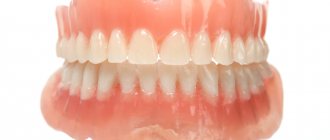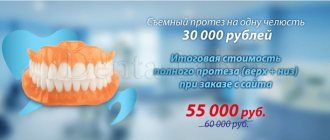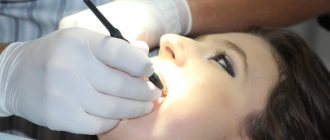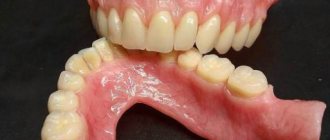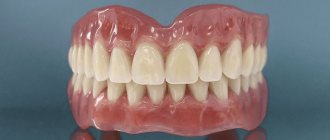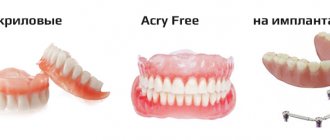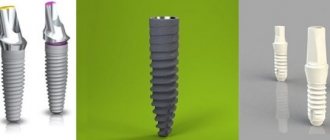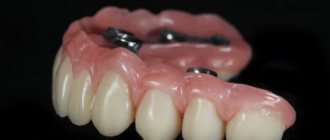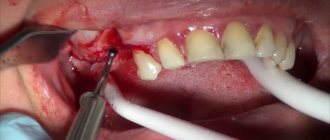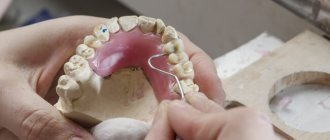The problem of recreating lost teeth arises not only due to age-related changes in the human body. Often young people also lose teeth: this can be caused by injuries, hereditary predisposition, or the environmental conditions of the person’s place of residence. If one tooth is lost or partially destroyed, the client of the dental clinic has many options for restoring it (veneers, crowns, inlays, implants, etc.).
The situation is more complicated when a person needs dental prosthetics in the absence of a large number of teeth: in this situation, based on the individual picture, the dentist often offers only one of the ways to recreate the dentition.
Modern dentistry has many different materials and methods of prosthetics in different situations, each of them has its own advantages and disadvantages, differs from others in the complexity of installation and cost. If you have lost several adjacent teeth or have no molars at all, we will tell you how to get dentures and what to pay attention to. The dentists at the Meliora Dent clinic will help you find the right option based on your specific situation and in accordance with the client’s requirements and capabilities.
| Prices and methods of dental prosthetics in the absence of more teeth | |
| Metal-ceramic crown | from 15000 R |
| Metal-free crown | from 25000 R |
| Zirconium crown | from 25000 R |
| Plastic prosthesis | from 22500 R |
| Nylon prosthesis | from 22500 R |
| Clasp prosthesis | from 22500 R |
| Dental implantation | from 25000 R |
Reasons for missing teeth
1-2% of the population has a genetic disorder in which teeth are initially absent or their number is abnormally small. In the vast majority of cases, the absence of lower or upper teeth is a consequence of illness or mechanical damage. Doctors at the clinic name the main reasons:
- Untreated caries or pulpitis. Tooth tissues are destroyed, in advanced cases, inflammatory processes in the gums begin, and the bone structure changes. Our dentists try to preserve every unit. But, if the process is already irreversible, then it is necessary to remove one tooth or several.
- Inflammatory processes in periodontal tissues lead to the fact that the ligament cannot hold the tooth in the socket. The crown becomes loose, destructive phenomena progress, and the gums and bone are destroyed.
- Injuries. The complete absence of teeth or partial adentia is caused by dislocations, bruises, fractures of the tooth crown or root, and other damage resulting from mechanical impact.
Sometimes teeth can be lost after suffering from somatic diseases: oncological, endocrine, and others that weaken the immune system and affect the structure of tissues.
Teeth Replacement Options
Dentists offer several effective ways to solve the problem of missing teeth in the oral cavity, these are:
- How long does it take for drugs to leave the body?
- installation of implants;
- installation of crowns on preserved tooth fragments or on adjacent teeth;
- creation of a bridge prosthesis.
To choose a method suitable for a particular patient, the dentist must first familiarize himself with the patient’s disease picture. So, if part of a tooth is present, it makes sense to put a crown on it. If the teeth on the sides of the tooth extraction site are healthy, then an implant can be placed. For dentures, the dentist will remove some of the pulp and grind down the edges of the existing teeth.
The dentist must first familiarize himself with the patient’s disease picture
It is also important to decide on the material from which the tooth replacement will be made. At this stage, a consultation with an orthodontist is also advisable. The doctor may use:
- metal;
- metal ceramics;
- metal-free ceramics.
It is worth focusing on each of the options separately.
Why do you need to restore your teeth?
Edentia is not only discomfort, but also early aging. The absence of teeth leads to changes in facial features, sunken cheeks, and the appearance of deep wrinkles. The person looks older, his appearance becomes sickly. In addition to visible imbalances in proportions and a deterioration in the quality of life, when there are no teeth at all, health problems
:
- The diet is reduced, the body does not receive the required amount of vitamins and minerals. The immune system suffers, metabolic processes are disrupted, and cells do not receive enough nutrients.
- Gastrointestinal diseases are provoked. Food is chopped poorly, making digestion difficult. Sometimes patients switch to eating pureed food or pureed food - this method also contributes to the appearance of dysfunction of the stomach and intestines.
- The absence of teeth in the jaws leads to improper distribution of the load on the gums and bone. Tissues atrophy and become thinner.
The bite also changes, diction is impaired - speech is slurred, most sounds are distorted. The absence of teeth affects the emotional state, lowers self-esteem, and the circle of friends narrows. Researchers have also established a direct connection with the presence of teeth and the state of intelligence and activity of older people.
Advantages of full implantation in terms of ease of eating
If we compare chewing efficiency with classic removable prosthetics and with implant-supported prosthetics, in the latter case it increases significantly, and, as is known, the quality of chewing food affects the condition of the gastrointestinal tract and the body as a whole. Owners of complete removable dentures have to regularly contact a gastroenterologist, who can only offer them to put food through a blender, but any person wants to eat well.
It is also worth noting that the process of chewing with the help of a complete removable denture constantly causes pain, since the structure puts pressure on the mucous membrane, under which there is a periosteum with many nerve endings. When the denture is installed supported by implants, there is no pain, since there is no pressure on the soft tissues.
Features of complete prosthetics
The clinics of the German Implantology Center in Moscow are a team of expert dentists who constantly improve their skills, participate in domestic and foreign symposiums, and introduce innovations. For more than 11 years of successful dental practice, we have been able to become a leader not only in Moscow, but also in Russia in the field of implantation and prosthetics.
Therefore, dental restoration in our clinics is as comfortable and painless for you as possible - safe anesthesia and sedation are used. The doctor tells you what symptoms may appear in the first days after surgery and prescribes medications appropriate to the case. The doctor is always in touch with the patient until complete healing.
Is it expensive to get teeth inserted?
Unfortunately, if you expect to receive the services of an orthopedic dentist under your insurance policy, then you will not be able to do this. Of course, if you belong to preferential categories of citizens, then you can use such medical care for free or receive substantial compensation. In other cases, you can only count on a tax deduction. Therefore, there is no big difference whether you go to a private or public dental clinic. Sometimes even commercial medical institutions hold promotions that will make prosthetics cheaper for you.
Prosthetics of the upper jaw on implants
Implantation in the complete absence of teeth in the upper jaw has its own nuances: osteoporosis of the bone progresses faster, there is an anatomical feature - a low alveolar ridge (its height is not enough to hold the pin), and the proximity of the maxillary sinus complicates the process.
The classic two-stage method is rarely used in this case. Bone grafting is an additional surgical intervention, and our doctors perform surgery when it is unavoidable. Therefore, preference is given to immediate implantation or gentle techniques.
All on 4 systems
"or "
All on 6
" allow you to quickly, with minimal trauma, restore the dentition when complete dental prosthetics are required in the upper jaw. These techniques are suitable for those who want to get quick and high-quality results. They are well tolerated by older people. If you replace your teeth completely, the healing time of the implants will be up to six months.
The “All on 4” and “All on 6” protocols differ in the number of supporting implants. The first method is suitable for patients with slight thinning of the bone and a small jaw, the second is acceptable for moderate and severe atrophy.
When implanting “All on 4”, two (four) implants are installed at an angle of 35-45 degrees in the lateral (sometimes distal) section, and two more are installed vertically on the front part of the jaw. Implantation at an angle allows you to bypass the maxillary sinuses. Doctors prefer to install dental implants in a minimally invasive way - through a puncture.
If it is not possible to install 4 implants in the complete absence of teeth, then it is possible to implant 2 pins, which will support a removable denture - the structure will be fixed better than the simple version with suction cups, the use of additional gels is not required.
When the tubular bone is too thin, a sinus lift will be required - this is how the volume of the maxillary sinuses is reduced and the bottom is corrected (raised). The voids are filled with synthetic material biocompatible with tissues. Implantation is possible approximately two months after the sinus lift.
If inflammatory diseases are observed (sinusitis, sinusitis), there is a cyst, or a deviated nasal septum, then bone grafting is performed only after anomalies have been excluded - treatment or surgery.
One of the features of implantation in the absence of teeth in the upper jaw is that the front teeth and part of the gums are visible when talking or smiling. Therefore, doctors solve two important problems: restore health and create an aesthetic image. Often artificial teeth turn out to be more beautiful than those given by nature and form the natural contour of the gums. The exact location of the implant is determined based on diagnostic images.
If the bone tissue deficiency is too acute and the augmentation operation is irrational, then it is possible - but at the stage of temporary prosthetics - to install zygomatic implants. In this way, it is possible to replace teeth completely with a small amount of spongy bone mass.
- Extended pins guarantee reliable fixation of the prosthesis in cases of total bone tissue deficiency, osteomyelitis and other clinical cases.
- Titanium implants from the Nobel Biocare line with a porous surface and a special coating are designed for rapid osseointegration.
- Artificial roots are implanted through surgery under anesthesia, bypassing the paranasal sinuses, into the deep cortical layer of the zygomatic bone. This is a complex operation, which is used only in special cases.
Before the operation of implantation of implants in any jaw, the doctor draws up a detailed treatment plan, because not only the beauty of the structure, but also the adequate distribution of the load on the artificial tooth root depends on the accuracy of each action and the correct selection of models of implants and prostheses.
Example #3. Prosthetics of the upper jaw on 8 implants
Our patient is quite young. I contacted the German Implantology Center with the problem of swelling, swelling, bleeding gums, discomfort, accompanied by periodic pain.
Based on the diagnostic results, it was found that all (!) of the existing teeth in the upper jaw are completely untenable due to the previously not entirely successful treatment in other clinics. Unfortunately, this problem is quite common:
The result of implantation and prosthetics of example #3 is presented below:
This clinical case is reviewed in more detail HERE.
Example # 3.1 - Upper jaw prosthetics on 7 implants
Our patient is a 70-year-old man
. I contacted the German Implantology Center with the following problem:
- There are only a few teeth left on the upper jaw,
- Some of the destroyed teeth were roots.
Before making a decision, the patient was constrained by the fact that there were 7 teeth left in the upper anterior section. They provided some (tolerable for many men) aesthetics. But when the man finally fully analyzed the situation for himself, he realized that chewing with so many teeth was, to put it mildly, uncomfortable for him and agreed to a step-by-step and rather complicated dental prosthetics procedure for him. Why was dental prosthetics difficult? Because it was done in several stages, and not all at once in one operation.
We will also not dwell on this clinical case now; we will show BEFORE and AFTER photos.
This is the situation a patient came to us
:
And this is what we have as a result of prosthetics
:
You can view this rather complex clinical case in detail HERE.
Is it possible to install mini-implants with complete edentia?
There are certain indications for mini-implants. The main thing is a narrow alveolar ridge, into which it is impossible to install standard-sized implants without replanting bone material. Naturally, osteoplastic surgery increases the cost of the procedure, so many patients prefer more affordable treatment with mini-implants. However, oddly enough, it does not differ much in cost from conventional implantation and, moreover, is associated with certain difficulties.
The main feature of mini-implants is that, unlike classical designs, they are non-removable, that is, they do not require the installation of an abutment. Crowns or bridges are installed directly on the tip of the implant, which acts as a kind of lock. Such a unique structure of the implant imposes certain obligations on the specialist and requires special skills from him. Firstly, mini-implants must be installed strictly parallel to each other, otherwise the prosthesis attached to them will not fit tightly in the oral cavity. And secondly, the load exerted on the structure must be minimal, otherwise there is a risk of rejection.
Prosthetics of the lower jaw on implants
The structure of the lower jaw is different - the bone mass is denser and thicker, the installation of a lower prosthesis in the absence of teeth, and the implantation of implants have other features.
“All on 4” protocols, as mentioned earlier, in most cases allow for complete restoration of teeth. The healing process is faster - the vast majority of patients forget about the presence of artificial teeth after three months. This is possible due to the increased density and sufficient height of the bone. The method is recommended for lack of volume (short length, thickness), atypical location of the mandibular canal.
Example #4 - All on 4 implantation with lower jaw prosthetics
Our patient is 82 (!) years old
. For the last 10 (!) years I have been trying to carry out treatment - restoration of the dentition with the help of implants. But, unfortunately for him, it was not successful - the implants were lost for a number of reasons - they did not take root, they became inflamed. But we must give our patient his due - he did not lose hope. A man of very progressive thinking, he understood that the problem was not in his body, but that something else was happening that was preventing him from becoming the happy owner of a high-quality denture on implants.
The result of “All on 4” prosthetics is presented in the photo below:
More details about this interesting clinical case can be found HERE.
Free consultation on the cost of treatment in our dentistry
Leave a request and the clinic administrator will contact you within 15 minutes!
NOTE: Gold crowns are considered an outdated option, although even today some patients order dentures made from this precious metal. In this case, the cost of the crown will depend on the amount and weight of the metal, as well as its current price per gram.
Which crown to put on a tooth? The answer to this question depends on a number of factors - for example, when restoring chewing teeth, there is no point in spending money on expensive ceramic crowns, but in order to achieve high quality and maximum durability of prosthetics, you can install zirconium teeth.
Dental bridges
Bridges are used when it is necessary to install 2 teeth or restore more units in a row. Their basis is a frame on which artificial dental units are placed. The main condition for placing a bridge on teeth is the presence of teeth that will support the structure.
The price of bridges largely depends on the material used to make them. The most expensive option is ceramic and zirconium structures.
A separate type of fixed prosthesis are veneers and lumineers, used in aesthetic dentistry. It is impossible to replace a tooth lost due to injury or disease using veneers and lumineers, since they are attached to the surface of the teeth and are intended solely to eliminate aesthetic defects of the teeth.
How much does it cost to put veneers on teeth? The price of installing veneers will depend on the type of prosthesis: veneers can be composite, ceramic, zirconium.
Features of implantation and prosthetics on the lower jaw
The artificial root is more firmly fixed in the tissue, so the risk of rejection tends to zero. The mandibular bone atrophies more slowly after the loss of units, which reduces the likelihood of osteoplasty. For complete dental prosthetics on implants, we use the “All on 6” technique more often in most clinical cases. This guarantees the patient reliability and ease of use of the orthopedic construction, primarily in the long term.
The aesthetic side is important, but when working with the dental row below, more attention is paid to restoring functionality. There is a nuance: the surgeon’s work will require precision, since the trigeminal nerve passes at the base of the jaw and there is a risk of damage to it if the intervention is careless.
- Before implantation begins, during diagnostics the exact location of the branch of the trigeminal nerve is established, the structure of the tissues and the localization of nerves and vessels are clarified.
- Surgeons at the Research Center clinics are highly qualified, carry out diagnostics and know everything about the anatomical features of each patient, so implantation takes place without complications.
- The doctor selects not only the location of the implant, but also its size, which is especially important in the absence of teeth. If the location is too close, then the nerve trunk will need to be docked.
Example #5 - Lower jaw prosthetics on 6 implants ALL ON 6
Our patient is a woman with fairly progressive views on dental treatment and prosthetics. But a rather serious problem in her life is an allergy to antibiotics. Since she categorically did not want a removable denture, considering it archaic and uncomfortable, the patient began her independent attempts to improve her smile. And she did this at her own peril and risk in several clinics.
At first, she installed the implants without “covering up”—the subsequent use—of antibiotics. Some of the implantation went well, some not so much. Having suffered, the patient concluded that she still needed to turn to professionals and then, even without antibiotics, she would get the reliable and aesthetically beautiful result that she dreams of and really wants to achieve.
The photo shows a view of 6 implants installed on the lower jaw:
Photo after prosthetics
:
You can read more about this interesting clinical case HERE.
Implantation is the most modern technique for placing teeth
Implantation is a technique that allows you to place teeth and get the most reliable, durable and aesthetic result. This technology involves the use of special structures - dental implants, which are implanted into the jaw bone and act as an artificial analogue of the tooth root. A crown is placed on the implanted implant or a conditionally removable prosthesis is fixed.
Which tooth is better to put on implants? Implantation allows you to successfully restore both chewing units and anterior teeth that fall into the smile zone. get a dental implant in Moscow if you are completely missing teeth: special implantation protocols have been developed for this.
The prices at which a tooth can be placed in Moscow using implantation will depend on a number of factors: the type of implants, implantation technology, material of manufacture and type of denture.
Calculate the cost of treatment by taking a short test in 20 seconds!
Do not delay your treatment, because in this matter time plays against us.
Which prosthetics for the lower jaw is better?
Patients are often interested in which prosthetics are best for restoring lower jaw teeth. Progressive experts believe that implantation and installation of structures today is the optimal and gentle option to maintain quality of life at any age. Root-shaped implants for the lower units are selected taking into account the upcoming high chewing load.
We use the basal method of prosthetics on implants extremely rarely and only at the stage of temporary prosthetics in the distal part as part of the “All on 6 implants” protocol in the absence of teeth, severe tissue atrophy and the inability to install 2 classical artificial roots. Then the elongated implants are introduced into the deep layers of the jawbone during the formation of bone in the distal section after bone grafting. After the bone tissue has formed, the basal implants are removed and normal classical implants take their place. And after this, the patient undergoes permanent prosthetics on 6 implants.
Modern implant designs are characterized by directional threading; some models have a porous surface with a coating that accelerates the integration of the artificial root into the bone. Fixed dentures in the absence of teeth are installed on a larger number of supports, minimum 6-8. One- or two-stage protocols are warranted. In the first option, until complete engraftment, the patient wears a traditional removable denture; in the second, a temporary option with artificial gums attached to pins is installed.
The fixed structure consists of metal-free crowns (usually zirconium dioxide), there is no artificial gum, and there is no need to remove the denture for cleaning. It is enough to follow standard hygiene procedures.
The “All on 4” protocol is ideal for restoring missing teeth in the lower jaw, if it is small, and allows, in most cases, to avoid bone augmentation. This is usually a one-stage implantation with immediate loading. Primary stabilization is high, there is an orthopedic stage. Within a week after the implants are inserted, a temporary prosthesis is put on.
If the bone has atrophied and for some reason it is decided to give preference to classical implantation, then bone grafting will be required. Special membrane materials are used that are embedded in the bone and stimulate its development. After osteoplasty there is a rehabilitation period of 4 months. up to six months.
If the tooth is not removed, but simply severely damaged
A tooth can decay for various reasons – for example, due to injury. But most often, tooth decay is caused by caries, the treatment of which was not carried out on time. If a tooth is destroyed by more than 50%, the problem cannot be solved by installing a conventional filling. If you put a filling on such a tooth , it may not withstand the load, break or fall out. It’s even worse if the tooth breaks along with the filling and its root part is damaged. This tooth will have to be removed!
Sometimes special auxiliary elements - pins - are used to restore severely damaged teeth. You can put a tooth on a pin and get a fairly reliable and aesthetic restoration result, but again - only if the tooth is not more than fifty percent destroyed! Before placing a filling on a tooth on a pin , the doctor will assess the degree of destruction of the unit. If it is significant, it would be better to put a crown on the tooth! This will protect the tooth from destruction and will allow you to qualitatively restore its aesthetics and all important functional characteristics.
How much does it cost to put a filling on a tooth if it is badly damaged? The cost of installation will depend on the complexity of the treatment, the size of the filling, the material and type of pin that will be used in the process of tooth restoration. On average, put a filling on a tooth in Moscow for an amount ranging from 5 to 8,000 rubles.
If you want to find out the exact cost of the service before putting a filling on a tooth , visit our dental clinic in Moscow - “VENSTOM” and get the most detailed advice on the treatment and restoration of teeth from our specialists!
NOTE: If you have a filling installed, but your tooth hurts and the pain does not subside within several days, be sure to contact your dentist! Such a symptom may indicate poor-quality treatment that did not help stop the inflammatory process!
We insert the teeth completely: prosthetics of two jaws
Which prosthesis should I choose if I have no teeth at all? Contact the German Implantology Center - the doctor will choose a way to restore your health. Preference is given to implantation. The statement that it is expensive is outdated. Today you can get an installment plan. Implants are installed once and with a lifetime guarantee - clinic dentists work only with the premium segment from well-known manufacturers, and expensive traditional removable structures wear out and require replacement after 7-10 years.
Our Center is a certified partner of top-rated implant brands, which is why patients all over Russia and abroad trust us. If it is necessary to restore the dentition on two jaws, the treating doctor will prescribe an examination and draw up a detailed action plan for dental prosthetics on implants. A tomogram is performed, a 3D model or surgical template is created, providing a predictable result. We use the best tomograph models in the world – cone versions of the Planmeca line.
The dentist chooses the priority of actions and introduces implants according to the “All on 4” or “All on 6” protocols. These are ways to carefully, avoiding unnecessary trauma, improve the quality of life.
Dental implantation is completely performed in most cases without bone grafting.
- For total rehabilitation, sometimes 4 implants are enough to fix the prosthesis on the lower jaw - this is 20% of all requests.
- The bone of the upper jaw is more porous, so 6 supports may be needed to secure the structure - the need to use one of the methods will be discussed by the doctor during a consultation after the examination.
The treatment plan must be discussed with the patient.
Example #6 - Prosthetics of both jaws with implantation ALL ON 6
Our patient is a 49-year-old man. I came across the following difficult situation:
- severe periodontitis,
- partial absence of teeth,
- numerous caries, incl. deep
- bone tissue atrophy.
The situation was more than serious, look for yourself at the photo BEFORE the start of treatment
:
The result of the prosthetics exceeded all the patient’s wildest expectations, see for yourself:
And with a smile, the result of ALL ON 6 is simply fantastically beautiful:
You can read this clinical case in detail HERE.
Advantages of the “Teeth in 1 Day” method:
- The operation can be performed in the presence of bone tissue atrophy and some chronic diseases;
- Preparation takes minimal time;
- The minimally invasive operation is performed immediately after the removal of natural teeth;
- Prosthetics are possible on the day of surgery;
- The quality of original products meets high quality standards;
- The service life of implants is 25 years, temporary prosthesis - 3 years, permanent prosthesis up to 15 years;
- Optimal price-quality ratio.

